Are you curious and asking; is a Merle Pitbull rare and wondering if they’re rare? You’re not alone! The Merle pattern, characterized by a marbled coat of darker and lighter patches, is indeed rare in Pitbulls, making these dogs quite unique and eye-catching.
Merle Pit bulls are so rare that the American Dog Breeders Association stopped tracking them in 2005. Their unique coat patterns and eye colors make them fascinating and a bit of a mystery. This has sparked both interest and debate among dog lovers.
This guide takes you into the fascinating world of Merle Pit bulls, where we will cover their special traits, history, and the ethics of breeding them.
If you love Pit bulls or just want to learn more, this article is for you. It aims to give you a full picture of this intriguing breed.
What is a Merle Pitbull?
Merle Pitbull is a variation of the American Pit Bull Terrier breed characterized by a unique merle coat pattern. The merle color pattern on these Pit Bulls can vary greatly, resulting in a mottled coat with patches of color.
While some view Merle Pit bulls positively for their expressive eyes and individuality, there is controversy within the American Pit Bull Terrier community about the legitimacy of the Merle coat color in purebred APBTs.
These dogs are not officially recognized by kennel clubs but have gained popularity for their distinct appearance and loyal nature.
Additionally, owning a Merle Pitbull can come with additional health considerations and a higher cost due to their rarity.
Is A Merle Pitbull Rare Distinctive Coat Color and Patterns
Merle Pitbulls are a unique breed with a special genetic trait. They come from mixing American Pit Bull Terriers with other breeds like Australian Shepherds or Catahoula Leopard Dogs. This mix leads to their distinctive coat patterns.
Their coat is short and smooth, showing off their striking markings. These patterns can vary, with some dogs having big solid color patches. Others have a marbled look. This unique coat pattern makes them highly sought after, with some puppies selling for up to $35,000.
However, the merle gene in Pit bulls is not without controversy. It can cause health issues like deafness, vision problems, and skin allergies. The United Kennel Club doesn’t accept merle Pit bulls as part of the breed. The merle gene is now very rare in American Pit Bull Terriers.
Pit bulls usually weigh between 35 to 60 pounds for males and 30 to 50 pounds for females. They are known for being friendly, with 87.4% passing temperament tests. Merle Pitbulls also tend to be friendly but might be cautious around new people and dogs due to their high energy.
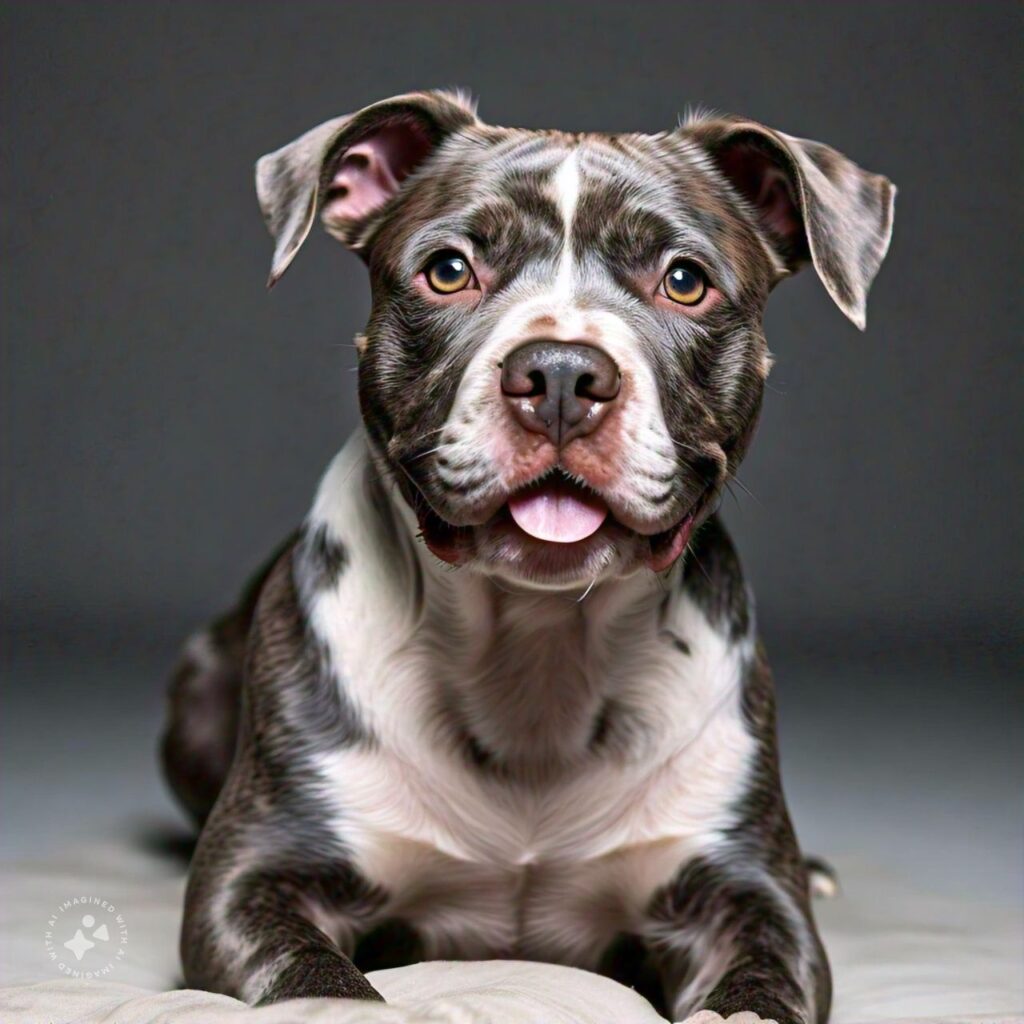
The Controversial History of Merle Pitbulls
The history of merle pit bulls is complex and has sparked debate. The pit bull breed has a long history, dating back to the 19th century. However, the merle coat pattern is not naturally found in purebred pit bulls. It is thought to have come from crossbreeding with breeds like the Australian Shepherd or Catahoula Leopard Dog, which carry the merle gene.
Pit bulls were once bred for tasks like hunting, sports, and protection. The merle gene, linked to health issues, was often removed to keep the breed strong. Merle pit bulls first appeared in 1922, but they were rare and often not encouraged because of health concerns.
The addition of the merle color to pitbulls has caused a lot of debate. The merle gene in pitbulls can cause deafness, vision problems, and skin allergies. That’s why groups like the United Kennel Club (UKC) don’t accept merle as a standard pitbull color, showing the controversy around their genetic makeup.
Some breeders still breed merle pit bulls, even though they charge more for their unique coats. This has raised ethical questions, as it can lead to double merle puppies with serious health issues. These puppies may have small eyes, cleft irises, deafness, and hearing loss.
Pitbull breeding for merle coats is a hot topic. The American Dog Breeders Association (ADBA) stopped registering merle pit bulls in 2005 because of health risks linked to the merle gene. The debate over the authenticity and ethics of breeding merle pit bulls continues to affect the breed’s history.

Is a Merle Pitbull Rare?
The debate about Merle Pit bulls has been ongoing in the dog breeding world. At first, the American Dog Breeders Association (ADBA) accepted Merle Pit bulls. But by 2005, they stopped registering them because of health issues linked to their color.
Despite this, their unique look has made some breeders keep producing them, often at high prices.
There’s also a debate about whether Merle Pit bulls are purebreds. Some say the merle gene came from crossbreeding, so they’re not true Pit bulls.
Others see them as a rare natural variation within the breed. This debate affects how the breed is seen, with groups like the United Kennel Club (UKC) not accepting merle as a standard Pitbull color.
Merle Pitbulls are rare for a few reasons:
- The merle gene is semi-dominant, so it can be passed on with just one copy.
- Breeders often don’t breed two merle dogs together because of health risks in the puppies.
- The American Pit Bull Terrier breed standard doesn’t include the merle coat pattern, so it’s not encouraged in breeding.
- Merle Pitbull puppies can cost up to $35,000, showing how rare and sought-after they are.
Merle Pit bulls stand out with their unique coats. But their rarity and the ethical issues in breeding them make them a complex topic in the Pitbull community.
The Unique Physical Traits of Merle Pit bulls
Merle Pit bulls are known for their special coat patterns and eye colors. They have a muscular, athletic body with a broad head and strong jaw. But what really makes them stand out is their coat and their eyes.
Eye-catching Eyes and Mesmerizing Coat Patterns
The merle coat pattern of Merle Pit bulls features patches of diluted color on a solid base. These colors can be blue, red, or fawn. This look creates a stunning visual effect, thanks to the merle gene.
Merle Pitbulls may also have blue or odd-colored eyes. This adds to their unique look. The merle gene affects pigmentation, making their eyes stand out.
The merle gene is what gives Merle Pit bulls their special coat patterns. These patterns can be minimal or cover most of their body. This makes each Merle Pitbull truly unique.
The striking coat and captivating eyes of Merle Pit bulls make them a standout breed. Their looks are a result of their unique genetic traits. This makes them visually stunning and memorable.
The Temperament and Personality of Merle Pitbulls
Merle Pit bulls are known for being affectionate, loyal, and confident. They love being around people and form strong bonds with their families. They need regular exercise and mental challenges to be happy and healthy.
These dogs are usually great with kids, earning them the nickname “nanny dogs.” But, they need proper training and socialization. Some may react badly to other animals because of their unique breeding.
Their coat patterns come from a genetic mutation that affects how their fur colors. This makes Merle Pit bulls stand out. But, their coat color doesn’t define their character. With the right care, they can be great companions.
Merle Pit bulls have the same temperament as regular Pit bulls but face health risks from the merle gene. It’s key to pick a responsible breeder to avoid issues like vision and hearing problems. Always research and choose a reputable breeder for a Merle Pitbull.
Caring for a Merle Pitbull
Caring for a merle pitbull means paying extra attention to their exercise, grooming, and health. These dogs need regular physical and mental activity to stay happy and healthy.
Exercise, Grooming, and Health Monitoring
Merle pit bulls have lots of energy, especially when they’re young. They need a lot of daily exercise to be content and healthy. Activities like long walks, runs, fetch, and agility training are great for them.
Their coat is short and smooth, making grooming easy. But, it doesn’t protect them well in extreme weather. So, they need regular brushing and baths.
It’s important to take them to the vet often to check for health issues linked to the merle gene. Merle pit bulls might face problems like deafness, vision issues, and skin allergies. Owners should work closely with their vet to keep their merle pitbull healthy.
The merle pattern in pit bulls comes from a dominant gene. A dog only needs one copy of this gene to show the unique coat colors. But, having two copies from both parents increases the risk of serious health issues like blindness and deafness.
This highlights the need for careful breeding and caution when thinking about getting a merle pitbull.
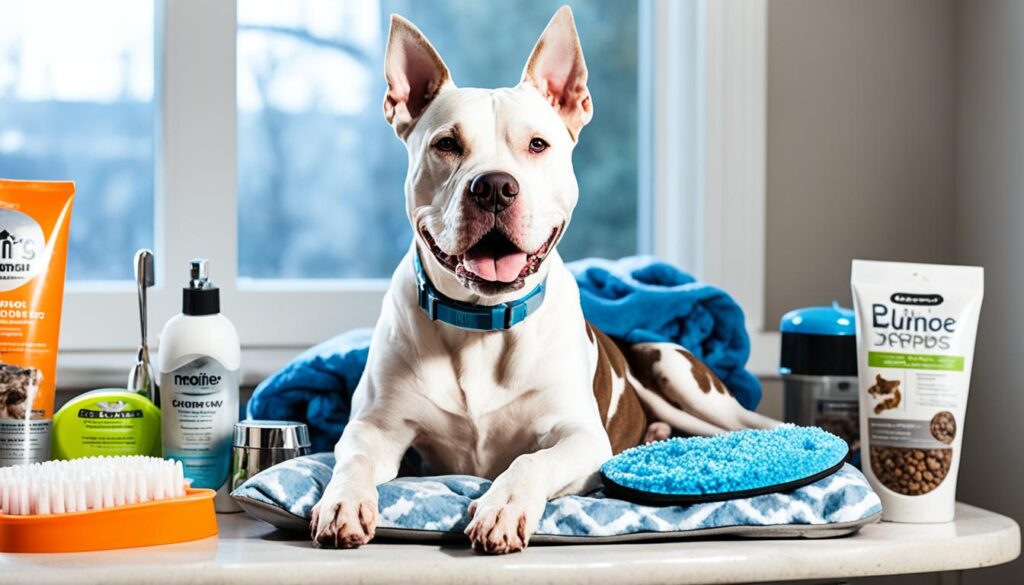
Looking after a merle pitbull means being proactive with their exercise, grooming, and health. By knowing the challenges of the merle gene, owners can give their merle pitbull the best care possible.
The Ethical Considerations of Breeding Merle Pitbulls
The history of Merle Pitbulls is filled with controversy. People argue about their genetic makeup and how they are bred. The merle coat pattern is eye-catching, but it comes with health risks. This has led many experts and animal groups to speak out against breeding Merle Pitbulls.
The merle gene can lead to deafness and vision issues in dogs. These health problems raise big ethical questions about the dogs’ welfare. Studies show that merle dogs often face hearing loss, from mild to total deafness, at a rate of 36.8%. They also have a higher chance of eye problems than non-merle dogs.
Some believe Merle Pitbulls are not true Pitbulls because they come from crossbreeding. This debate affects the future of the Merle Pitbull breed. The American Bully Kennel Club, for example, sees merle as a fault, not allowing it in their breed standards.
The merle gene is now found in many breeds, causing ethical worries. When two merle dogs have puppies, there’s a 25% chance of getting a double merle. These puppies often have a white coat and face a high risk of deafness, blindness, or both.
Responsible breeders and animal welfare groups stress the need to put the dogs’ health and happiness first. They say breeding two merle dogs is wrong because it increases the risk of health issues in the puppies.
Even with ethical concerns, Merle Pitbulls are still in demand, with some selling for up to $5,000. This has sparked worries about bad breeding practices, like illegal dogfighting and the misuse of ‘game-bred’ labels.
The debate on Merle Pitbull breeding is ongoing, but there’s hope for change. Breeders are focusing more on health tests, genetic diversity, and the dogs’ overall welfare. This could lead to more responsible breeding practices in the Pitbull community.
Conclusion
Merle Pitbulls stand out with their unique coat patterns and eye colors. Their looks have made them popular, but the merle gene’s health issues have caused debate. Before bringing one home, potential owners should think about their needs and health concerns.
It’s crucial to breed responsibly and care for these dogs’ well-being. Merle Pitbulls need extra attention and owners must be ready for the challenges they may face. By focusing on their health, breeders and owners can support the breed’s responsible care and stop harmful practices.
Deciding to get a Merle Pitbull should be thoughtful and informed. With the right care and responsible ownership, they can be great pets. Yet, their health and happiness should always come first.

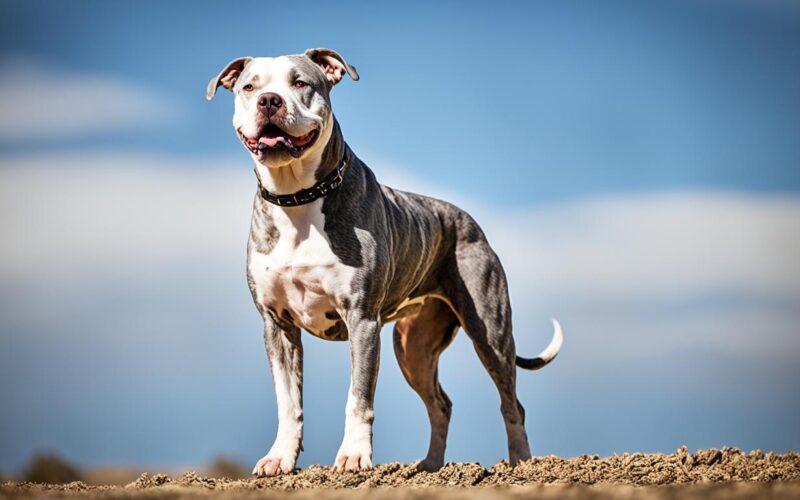

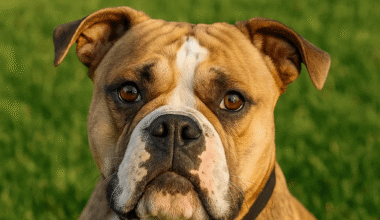
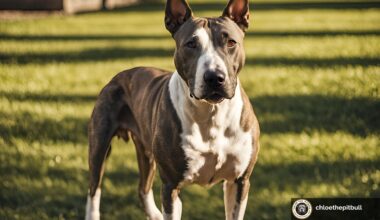



77 comments
Morning
Looking to improve your posture and live a healthier life? Our Medico Postura™ Body Posture Corrector is here to help!
Experience instant posture improvement with Medico Postura™. This easy-to-use device can be worn anywhere, anytime – at home, work, or even while you sleep.
Made from lightweight, breathable fabric, it ensures comfort all day long.
Grab it today at a fantastic 60% OFF: https://medicopostura.com
Plus, enjoy FREE shipping for today only!
Don’t miss out on this amazing deal. Get yours now and start transforming your posture!
All the best,
Alannah
What if you could get business funding—without the hassle?
No credit checks, no paperwork, no sales calls. Just instant approvals and next-day funding.
See what you qualify for in 30 seconds—it’s fast, easy, and risk-free!
Don’t wait-Apply Now: http://www.nextdayworkingcapital.com/approval
Trusted by thousands of small business owners. Over 600 million funded to businesses like yours!
If you no longer wish to receive marketing messages from us, you can unsubscribe at nextdayworkingcapital.com/unsubscribe
Business Funding on Your Terms—No Credit Check, No Hassle.
Get fast, flexible working capital without the usual roadblocks.
Instant approvals, next-day funding, and no paperwork required.
Check your eligibility in 30 seconds—100% free!
See what you qualify for: http://www.nextdayworkingcapital.com/approval
Trusted by thousands of small business owners. Over 600 million funded to businesses like yours!
If you no longer wish to receive marketing messages from us, you can unsubscribe at nextdayworkingcapital.com/unsubscribe
If you are reading this message, That means my marketing is working. I can make your ad message reach 5 million sites in the same manner for just $50. It’s the most affordable way to market your business or services. Contact me by email virgo.t3@gmail.com or skype me at live:.cid.dbb061d1dcb9127a
P.S: Speical Offer – ONLY for 24 hours – 10 Million Sites for the same money $50
Are you still struggling to rank on Google? Our SEO experts can help. Contact https://hireseogeek.com/?src1=chloethepitbull.com
Hi there,
We run a YouTube growth service, which increases your number of subscribers both safely and practically.
– We guarantee to gain you 700-1500+ subscribers per month.
– People subscribe because they are interested in your channel/videos, increasing likes, comments and interaction.
– All actions are made manually by our team. We do not use any ‘bots’.
The price is just $60 (USD) per month, and we can start immediately.
If you have any questions, let me know, and we can discuss further.
Kind Regards,
Amelia
FYI, I came across you guys and was checking out your website. It’s good! But I did find a couple of issues that are holding you down in Google search results.
If you’d like, I am happy to make you a quick website video audit walking you through those fixes… no strings attached.
No worries if you are not interested, but I just wanted to offer.
Let me know if I can do that for you.
My email: globalpanther@gmail.com
Skype: live:.cid.44cd50da56c7b19b
Samantha Val
Are you ready to earn money from your website with minimal effort? With ForeMedia.net, you can start making revenue from ad impressions alone—clicks are just a bonus!
Here’s why website owners love us:
✅ Instant approval for new publishers
✅ Earnings from traffic, not just clicks
✅ Hassle-free setup in minutes
Register Now Her: https://foremedia.pro/CU4W6 and start monetizing your traffic today!
Best,
The ForeMedia Team
We improve MOZ Domain authority 30+ in 25 Days its help to improve google rank, improve your website SEO, and you get traffic from google
DA – 0 to 30 – (Only $29) – Yes, Limited time !!
>> 100% Guarantee
>> Improve Ranking
>> White Hat Process
>> Permanent Work
>> 100% Manual Work
>> 0% Spam score increase
⚡ From our work your website keyword get rank on google and get organic traffic from google through keywords
Contact now: intrug@gmail.com
Hi,
We are offering 10,000+ Sudoku puzzles, Word Searches, and Crosswords in print-ready PDF format.
What you get:
High-resolution PDFs optimized for A4 printing.
Instant download after purchase.
Perfect for home printing or print-on-demand services.
Freedom to sell printed versions offline at markets, bookstores, or fairs
Our puzzles are professionally designed to ensure crisp, vibrant prints. Plus, we offer a 30-day unconditional money-back guarantee if you’re not completely satisfied.
Visit for more information: https://furtherinfo.info/puzzles
Kind Regards,
Bradly
Advantages of hiring a Developer:
Specialized Expertise
Tailored Customization and Control
Time and Cost Efficiency
Custom Plugin Development
SEO Optimization
Ongoing Support and Maintenance
Seamless Integration and Migration
Scalability for Business Growth
Hire a web developer now from us. Contact us at lisa365chat@gmail.com
Advantages of hiring a Developer:
Specialized Expertise
Tailored Customization and Control
Time and Cost Efficiency
Custom Plugin Development
SEO Optimization
Ongoing Support and Maintenance
Seamless Integration and Migration
Scalability for Business Growth
Hire a web developer now from us. Contact us at lisa365chat@gmail.com
I don’t think the title of your article matches the content lol. Just kidding, mainly because I had some doubts after reading the article.
Hello, are you wasting money in Google Ads & No results? Start Free Trial & You don’t need to Pay Advance!
I do SEO Marketing and improve Website Traffic, Google Rankings, Organic results, Sales & conversions.
I have more than 12 years of experience in Search Engine Optimization Marketing & our every client gets amazing results. Please check our client’s results at our website.
Start Free Trial: monthlyseo2025@outlook.com
Hello, are you wasting money in Google Ads & No results? Start Free Trial & You don’t need to Pay Advance!
I do SEO Marketing and improve Website Traffic, Google Rankings, Organic results, Sales & conversions.
I have more than 12 years of experience in Search Engine Optimization Marketing & our every client gets amazing results. Please check our client’s results at our website.
Start Free Trial: monthlyseo2025@outlook.com
Are you looking for Web design/ Development for your business? contact us at t3.technology@outlook.com
Are you looking for Web design/ Development for your business? contact us at t3.technology@outlook.com
Hi there,
We wanted to introduce you to a revolutionary system that helps you create AI-powered tools to generate steady, qualified leads without paid advertising.
Key benefits:
Create AI tools in minutes with simple copy/paste templates
Drive free, targeted traffic to any niche or offer
Built-in call-to-action system to funnel leads to your sales pages
No coding or technical experience needed
We’re currently offering a special launch price of $17 (regular $97) which includes bonus training on traffic generation and AI monetization.
For more details, check out: https://furtherinfo.info/etb
Thanks,
Leesa
We improve MOZ Domain authority 30+ in 25 Days its help to improve google rank, improve your website SEO, and you get traffic from google
DA – 0 to 30 – (Only $29) – Yes, Limited time !!
>> 100% Guarantee
>> Improve Ranking
>> White Hat Process
>> Permanent Work
>> 100% Manual Work
>> 0% Spam score increase
⚡ From our work your website keyword get rank on google and get organic traffic from google through keywords
Contact now: intrug@gmail.com
We improve MOZ Domain authority 30+ in 25 Days its help to improve google rank, improve your website SEO, and you get traffic from google
DA – 0 to 30 – (Only $29) – Yes, Limited time !!
>> 100% Guarantee
>> Improve Ranking
>> White Hat Process
>> Permanent Work
>> 100% Manual Work
>> 0% Spam score increase
⚡ From our work your website keyword get rank on google and get organic traffic from google through keywords
Contact now: intrug@gmail.com
Your point of view caught my eye and was very interesting. Thanks. I have a question for you.
Hi,
I’m Dr. Brown, MBA, owner of Test First Drug & Alcohol Testing, a Houston-based TPA offering DOT/non-DOT drug testing, physicals, and compliance support. Through our partnership with eScreen, we provide access to 5,100+ sites nationwide.
We serve trucking, logistics, and businesses with 50+ employees, helping reduce drug testing costs by 10–50%.
✅ Drug & alcohol testing
✅ DOT physicals
✅ Mobile/on-site service
✅ Compliance tracking
Let’s connect!
testfirstads@gmail.com
testfirsthouston.com
Best,
Dr. Brown, MBA
Hi,
I just visited chloethepitbull.com and wondered if you’d ever thought about having an engaging video to explain what you do?
Our videos cost just $195 for a 30 second video ($239 for 60 seconds) and include a full script, voice-over and video.
I can show you some previous videos we’ve done if you want me to send some over. Let me know if you’re interested in seeing samples of our previous work. If you are not interested, just use the link at the bottom.
Regards,
Joanna
Unsubscribe: https://removeme.live/unsubscribe.php?d=chloethepitbull.com
If you are reading this message, That means my marketing is working. I can make your ad message reach 5 million sites in the same manner for just $50. It’s the most affordable way to market your business or services. Contact me by email virgo.t3@gmail.com or skype me at live:.cid.dbb061d1dcb9127a
P.S: Speical Offer – ONLY for 24 hours – 10 Million Sites for the same money $50
Struggling to rank on Google? Our high-quality backlink services will push your site to the top. Trusted by businesses worldwide! Start now and watch your traffic soar!
We Create 1200 Backlinks for you in Just $12
> Boost Google Ranking
Get HIGH-QUALITY backlinks for any website
Backlink works for GMB, MAP, Youtube Videos ALSO
Backlinks from Blogs, Wiki Articles, Social BookMarking etc
Report within 10 days
Boost Your Website Visitor And REVENUE
Contact us at scmouli31@gmail.com
Hello, are you wasting money in Google Ads & No results? Start Free Trial & You don’t need to Pay Advance!
I do SEO Marketing and improve Website Traffic, Google Rankings, Organic results, Sales & conversions.
I have more than 12 years of experience in Search Engine Optimization Marketing & our every client gets amazing results. Please check our client’s results at our website.
Start Free Trial: esolu.s@gmail.com
If you are reading this message, That means my marketing is working. I can make your ad message reach 5 million sites in the same manner for just $50. It’s the most affordable way to market your business or services. Contact me by email virgo.t3@gmail.com or skype me at live:.cid.dbb061d1dcb9127a
P.S: Speical Offer – ONLY for 24 hours – 10 Million Sites for the same money $50
Hi,
I just visited chloethepitbull.com and wondered if you’d ever thought about having an engaging video to explain what you do?
Our videos cost just $195 (USD) for a 30 second video ($239 for 60 seconds) and include a full script, voice-over and video.
I can show you some previous videos we’ve done if you want me to send some over. Let me know if you’re interested in seeing samples of our previous work.
Regards,
Joanna
Unsubscribe: https://removeme.live/unsubscribe.php?d=chloethepitbull.com
Hi there,
We run a Youtube growth service, where we can increase your subscriber count safely and practically.
– Gain 700-1500+ real, human subscribers who subscribe because they are interested in your channel/videos.
– Safe: All actions are done, without using any automated tasks / bots.
– Channel Creation: If you haven’t started your YouTube journey yet, we can create a professional channel for you as part of your initial order.
If you are interested then we can discuss further.
Kind regards,
Amelia
Hey there,
Hope this finds you well. I work with small businesses that occasionally need fast, no-hassle funding—and thought I’d pass this along just in case.
We offer instant approvals (no credit pull or paperwork) with funding by the next day.
Here’s the link if it’s ever useful:
http://www.expresscapitalcorp.com/approval
Warm regards,
Emily Harper
Small Business Funding Specialist
Express Capital
If you no longer wish to receive marketing messages from us, you can unsubscribe at expresscapitalcorp.com/unsubscribe
Hi,
Are you struggling to get enough traffic to chloethepitbull.com? I’d like to introduce you to our promotional offer.
– Place any 2 URLs on 10 different traffic rotators for DAILY buyer traffic.
– No experience, email list, or tech skills required.
– Set up once and receive continuous traffic forever.
– Works for any niche or business model.
– Includes all top 10 bestselling traffic systems worth $3,970 combined.
Just 3 simple steps:
1. Purchase today before price increases
2. Submit your URLs following our instructions
3. Watch the daily traffic roll in automatically
Backed by a 30-day money-back guarantee so if you aren’t happy, we’ll give you your money back, no questions asked.
Learn more: https://furtherinfo.info/10
Thanks,
Mackenzie
Hi there,
I know this is out of the blue, but I thought it might be helpful.
We offer simple business funding—no credit checks, no paperwork, and no sales calls.
You can see what you qualify for in 30 seconds:
http://www.expresscapitalcorp.com/approval
Wishing you continued success,
Jason Keller
Small Business Funding Specialist
Express Capital
If you no longer wish to receive marketing messages from us, you can unsubscribe at expresscapitalcorp.com/unsubscribe
Hi,
I’m Sachin, a senior web developer with over 10 years of hands-on experience in web design and development. I currently work with one of the top web development companies, delivering high-quality, scalable, and secure websites.
My hourly rate is $8.
My expertise includes:
* Custom website design (mockups and templates)
* Full website development (theme creation & backend customization)
* Responsive design for all screen sizes and devices
* Plugin and extension development
* Website speed optimization & on-page SEO
* Website security enhancements
* Website migration, ongoing support, and maintenance
If you have a project or specific requirement in mind, feel free to reach out—I’d be happy to discuss it further.
Email me at:
e.solus@gmail.com
Best regards,
Sachin
Hi there,
If you’re reading this, it means my marketing strategy is already working — and I can do the same for your business.
For just $50, I can help you reach over 5 million websites with your ad or promotional message. It’s one of the most cost-effective ways to boost visibility and drive results.
Special 24-Hour Offer:
Get your message on 10 million websites for the same $50 — available for a limited time only!
Interested?
Email me at virgo.t3@gmail.com
Let’s get your message out there!
Just reaching out in case you ever need quick access to working capital.
We provide funding with no credit checks, no documents, and next-day deposits.
Apply in 30 seconds here:
http://www.expresscapitalcorp.com/approval
All the best,
Michael Grant
Small Business Funding Specialist
Express Capital
If you no longer wish to receive marketing messages from us, you can unsubscribe at expresscapitalcorp.com/unsubscribe
Increase Your Website’s Domain Authority to 30+ in Just 25 Days – Only $29!
(Limited Time Offer)
Enhance your website’s Google ranking, SEO performance, and attract more organic traffic by raising your MOZ Domain Authority (DA) from 0 to 30+.
What’s Included:
1. 100% Guaranteed
2. Improved Keyword Rankings
3. White Hat SEO Methods
4. Permanent Results
5. Fully Manual Work
6. No Increase in Spam Score
Our SEO strategy helps your keywords rank on Google, driving real, organic traffic to your website.
Contact Us Today: intrug@gmail.com
EASE YOUR PAIN IN 10 MINUTES EFFORTLESSLY
Be Free from sore muscles and joint pain
Try FitRx Wireless Massager & Relieve YOUR Pain Effortlessly In 10 Min!
Save 50% OFF + FREE Priority Shipping
Shop Now: https://EaseRelief.net
Sincerely,
Marisa
Hello there
I wanted to reach out and let you know about our new dog harness. It’s really easy to put on and take off – in just 2 seconds – and it’s personalized for each dog.
Plus, we offer a lifetime warranty so you can be sure your pet is always safe and stylish.
We’ve had a lot of success with it so far and I think your dog would love it.
Get yours today with 50% OFF: https://caredogbest.com
FREE Shipping – TODAY ONLY!
Have a great time,
Alfonso
Why Hire a Professional Web Developer?
1. Expertise You Can Trust
Gain access to specialized skills and industry knowledge.
2. Fully Customized Solutions
Get complete control and tailored functionality to meet your unique needs.
3. Save Time and Money
Avoid costly delays and streamline development with efficient workflows.
4. Custom Plugin Development
Add powerful features designed specifically for your site.
5. SEO Optimization
Ensure your website ranks well and drives organic traffic.
6. Reliable Support & Maintenance
Enjoy ongoing technical assistance and peace of mind.
7. Smooth Integration & Migration
Seamlessly connect with existing systems or move from old platforms.
8. Scalable for Future Growth
Build a foundation that grows with your business.
Ready to Get Started?
Hire a professional web developer today.
Contact us at lisa365chat@gmail.com
My name is Ahmet. I’m a bank staff in a Turkish bank. I’ve been looking for someone who has the same nationality as you. A citizen of your country died in the recent earthquake in Turkey, he had in our bank fixed deposit of $11.5 million.
My Bank management is yet to know of his death. If my bank executive finds out about his death ,They would use the funds for themselves and get richer and I would like to prevent that from happening only if I get your cooperation, I knew about it because I was his account manager. Last week my bank management held a meeting for the purpose of a bank audit to note the dormant and abandoned deposit accounts. I know this will happen and that’s why I’m looking for a solution to deal with this situation because if my bank discovers his death, they will divert the funds to the board of directors. I don’t want that to happen.
I request your cooperation to introduce you as the kin/heir of the account as you are of the same nationality as him. There is no risk; the transaction is carried out under a legal agreement that protects you from infringement. I suggest we split the funds, 60/40 and 40 for me. I need this fund for my daughter’s surgery so keep this info confidential. email me so i can provide you with more information. ahmetaksoytrt@outlook.com
Your point of view caught my eye and was very interesting. Thanks. I have a question for you.
I don’t think the title of your article matches the content lol. Just kidding, mainly because I had some doubts after reading the article.
Hi there,
We’re helping small business owners access a flexible line of credit — up to $250,000 — with no credit pull and no document uploads.
You’ll get a decision in under 30 seconds. Use the funds when you need them, repay what you use, and draw again — no strings, no hassle.
Start here:
http://www.expresscapitalcorp.com/approval
Talk soon,
Emily Harper
Small Business Funding Specialist
Express Capital
To unsubscribe: expresscapitalcorp.com/unsubscribe
Your point of view caught my eye and was very interesting. Thanks. I have a question for you.
Good Morning,
I hope you’re doing well. I wanted to let you know about our new BANGE backpacks and sling bags that just released.
The bags are waterproof and anti-theft, and have a built-in USB cable that can recharge your phone while you’re on the go.
Both bags are made of durable and high-quality materials, and are perfect for everyday use or travel.
Order yours now at 50% OFF with FREE Shipping: http://bangeshop.com
Enjoy,
Tiffani
Hi there,
If your business needs flexible access to working capital, we can help.
We offer a revolving line of credit up to $250,000 — no credit checks, no paperwork, and no sales calls.
Approval takes less than 30 seconds and funds are available when you need them.
Check your eligibility here:
http://www.expresscapitalcorp.com/approval
Wishing you continued success,
Jason Keller
Small Business Funding Specialist
Express Capital
Unsubscribe anytime: expresscapitalcorp.com/unsubscribe
Hello there
Looking to improve your posture and live a healthier life? Our Medico Postura™ Body Posture Corrector is here to help!
Experience instant posture improvement with Medico Postura™. This easy-to-use device can be worn anywhere, anytime – at home, work, or even while you sleep.
Made from lightweight, breathable fabric, it ensures comfort all day long.
Grab it today at a fantastic 60% OFF: https://medicopostura.com
Plus, enjoy FREE shipping for today only!
Don’t miss out on this amazing deal. Get yours now and start transforming your posture!
Cheers,
Celia
Thank you for your sharing. I am worried that I lack creative ideas. It is your article that makes me full of hope. Thank you. But, I have a question, can you help me?
To the http://chloethepitbull.com/fekal0911 Owner
Hey there,
Most lenders slow you down with applications, phone calls, and red tape. We do it differently.
Get a business line of credit up to $250,000 — with no credit check, no documents, and no phone calls.
It’s fast, flexible, and built for real business owners.
It takes just 30 seconds to see what you qualify for:
http://www.expresscapitalcorp.com/approval
Here when you need us,
Michael Grant
Small Business Funding Specialist
Express Capital
No longer interested? Unsubscribe here: expresscapitalcorp.com/unsubscribe
Good Morning
Is your dog’s nails getting too long? If you’re tired of going to the vet or groomer to get them trimmed, why not try PawSafer™?
With PawSafer™, you can trim your dog’s nails from the comfort of your own home, and it only takes a few minutes!
PawSafer™ is the safest and most convenient way to trim your dog’s nails, and it’s very affordable.
Get it while it’s still 50% OFF + FREE Shipping
Buy here: https://pawtrim.shop
Many Thanks,
Steve
This isn’t a sales pitch — just a quick note to say we’re offering traffic to help sites like yours grow.
https://realwebsitevisitors.my
Dear Founder,
An active investor we represent is now reviewing investment ready business ideas across all sectors no matter your industry or stage. What matters most is a compelling, scalable idea with strong execution potential.
Available Funding Options:
• 3% annual interest rate
• No early repayment penalties
• Convertible loan option available – convert to 10–15% equity after 2 years (optional)
Whether you’re building the next big tech platform, expanding a niche brand, or launching a bold new venture, now’s your chance to access smart capital on founder-friendly terms.
Simply send in your pitch deck or business plan to start the conversation. If your idea is solid, we’re ready to move.
Let’s help you bring your vision to life.
Yours Truly,
Oma Marshal
Investment Consultant/Strategist
Email: omaman111@proton.me
Hey there
I wanted to reach out and let you know about our new dog harness. It’s really easy to put on and take off – in just 2 seconds – and it’s personalized for each dog.
Plus, we offer a lifetime warranty so you can be sure your pet is always safe and stylish.
We’ve had a lot of success with it so far and I think your dog would love it.
Get yours today with 50% OFF: https://caredogbest.com
FREE Shipping – TODAY ONLY!
Regards,
Iola
Your article helped me a lot, is there any more related content? Thanks! https://www.binance.info/uk-UA/join?ref=UM6SMJM3
EASE YOUR PAIN IN 10 MINUTES EFFORTLESSLY
Be Free from sore muscles and joint pain
Try FitRx Wireless Massager & Relieve YOUR Pain Effortlessly In 10 Min!
Save 50% OFF + FREE Priority Shipping
Shop Now: https://EaseRelief.net
Have a great time,
Hyman
Your business could receive up to $500,000 in working capital based entirely on your revenue — no credit check, no collateral. Apply today and funds could be in your account tomorrow: https://fastbizfunds.capital
https://t.me/s/TgGo1WIN/3
Официальный Telegram канал 1win Casinо. Казинo и ставки от 1вин. Фриспины, актуальное зеркало официального сайта 1 win. Регистрируйся в ван вин, соверши вход в один вин, получай бонус используя промокод и начните играть на реальные деньги.
https://t.me/s/Official_1win_kanal/1121
Looking for quick, no-hassle business funding? Apply in 30 seconds for a loan or line of credit no mountains of paperwork, and funding in as soon as 24 hours. Get started: https://fastbizfunds.capital
Quick, simple, and flexible get the working capital you need with a 30-second approval and next-day funding. Apply now: https://smallbizline.com
Thank you for your sharing. I am worried that I lack creative ideas. It is your article that makes me full of hope. Thank you. But, I have a question, can you help me? https://www.binance.info/en-IN/register?ref=UM6SMJM3
Thank you for your sharing. I am worried that I lack creative ideas. It is your article that makes me full of hope. Thank you. But, I have a question, can you help me? https://www.binance.info/bg/register?ref=V2H9AFPY
Hello Chloethepitbull Com,
Want consistent uploads without burning out?
AI outlines, scripts, and edits do the heavy lifting
B-roll and stock are handled for you
200+ voices = on-brand narration in seconds
Monetization-safe for channels and sponsors
Create your next video today:
→ https://video-gen-ai.blogspot.com
Tip: Batch 5 scripts, then render all at once—stay 2 weeks ahead with one afternoon of work.
To your viral success,
[Zoe Hass]
Empowering Your Digital Marketing Success
Your point of view caught my eye and was very interesting. Thanks. I have a question for you.
Hi,
Not every loan works for every business, which is why at Capital Funding Store we approve a range of programs directly in-house.
For growth and expansion, we offer 3–5 year term loans with rates starting around 6% for qualified applicants. For flexibility, we provide revolving lines of credit, giving you continuous access to funds. And for urgent cash flow gaps, we approve working capital up to $250,000, often funded within 24 hours.
All approvals are made directly by us, so you know you’re dealing with the lender — not a middleman.
See what you qualify for by completing our approval form:
https://capitalfundingstore.com/approval
– Michael White, Capital Funding Store
Thank you for your sharing. I am worried that I lack creative ideas. It is your article that makes me full of hope. Thank you. But, I have a question, can you help me?
Your article helped me a lot, is there any more related content? Thanks! Pieregistrējieties, lai sanemtu 100 USDT
Your point of view caught my eye and was very interesting. Thanks. I have a question for you.
I don’t think the title of your article matches the content lol. Just kidding, mainly because I had some doubts after reading the article.
Your article helped me a lot, is there any more related content? Thanks!
Your article helped me a lot, is there any more related content? Thanks!
Your article helped me a lot, is there any more related content? Thanks!
Can you be more specific about the content of your article? After reading it, I still have some doubts. Hope you can help me.
Anytime you need extra business funding, the last thing you want is a delay or hidden fees.
Reachout Capital is a true direct lender that keeps things simple — a single step, three business-funding choices, and no credit pull.
Pick between:
• Business Line of Credit
• Merchant Cash Advance (MCA)
• 3 to 5 year financing plan
See your tailored options in under one minute at:smallbizline.com
Most businesses are approved in hours and funded by the next day.
Rapid decisions. Clear terms. Reliable funding.
Skip the bank delays. Access up to $250K for your business — all based on your sales, not your credit. No collateral or credit checks and same-day approvals.
Text “OFFER” to (678) 568-2638 for instant details.
Stop waiting on banks. Get up to $250K for your business — all based on your sales, not your credit. No collateral required and same-day approvals.
Visit https://reachoutcapital.com/offers to see all three offers we have available for you to consider. Takes less than a minute